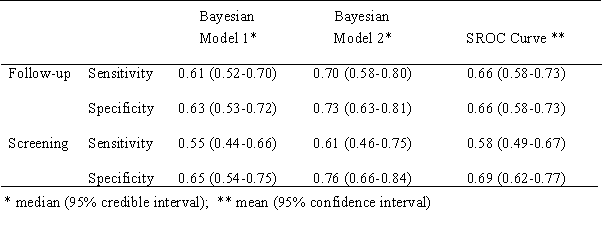Purpose: The purpose of this study is to reanalyze a published meta-analysis of Papanicolau (Pap) smears (Fahey, et al. Am J Epidemiol 1995; 141:680-689) using Bayesian approaches and compare the results.
Methods: The Fahey study considered two subgroups for summary receiver operating characteristic (SROC) curve analysis: one subgroup (N=31 studies) used Pap smear as a follow-up test after a previous abnormal result; the other (N=27) used Pap smear for screening. We considered two Bayesian hierarchical models for each subgroup. The first model considered true positives and true negatives as binomial random variables, with sensitivity (b) and specificity (a) as the probability parameters, respectively. We assumed that sensitivity and specificity have independent beta distributions with exponential prior on the beta parameters. The second model considered sensitivity and specificity jointly through the log odds ratio, , where d followed a normal distribution, which allowed for possible correlation between sensitivity and specificity. We performed sensitivity analysis to examine the effect of prior selection on the parameter estimates.
, where d followed a normal distribution, which allowed for possible correlation between sensitivity and specificity. We performed sensitivity analysis to examine the effect of prior selection on the parameter estimates.
Results: We examined the possible existence of publication bias using funnel plots. Plots using the second model had the expected funnel shape. The table compares the estimates of overall sensitivity and specificity from the Bayesian models with Fahey's SROC results. Results from Bayesian model 1 are similar to the SROC approach but with wider credible intervals. The point estimates from Bayesian model 2 are higher although the credible intervals overlap. Sensitivity analysis showed that the models are somewhat sensitive to the variance of the prior distribution; however, the point estimates are more robust.

Conclusions: We concluded that the Bayesian approach has advantages over SROC in that it accounts for between-study variation and allows for estimating the sensitivity and specificity in a particular trial, taking the results of other trials into consideration, i.e. "borrowing strength" from one another. The log odds ratio model, allowing for correlation, produced higher point estimates for both sensitivity and specificity.


![]() , where d followed a normal distribution, which allowed for possible correlation between sensitivity and specificity. We performed sensitivity analysis to examine the effect of prior selection on the parameter estimates.
, where d followed a normal distribution, which allowed for possible correlation between sensitivity and specificity. We performed sensitivity analysis to examine the effect of prior selection on the parameter estimates.